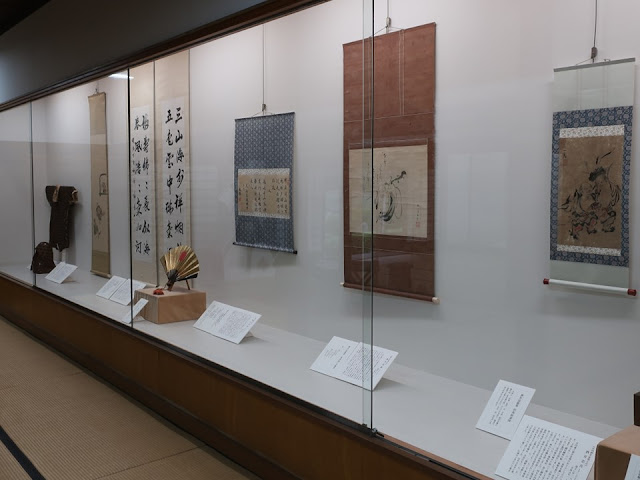Link to Part 1 of this article (Exhibits of old fishing tools, sake containers, clothes and so on)、パート1(←リンク)は、昔の漁具や酒樽、衣服などです。
博物館の許可を得て撮影、及び掲載しました。
Former Shibuya Family Residence、多層民家(旧渋谷家住宅)
The building above was built in 1822 at Tamugimata village which is a heavy snowfall area. It was moved here in 1965. The house was used as a lodge for pilgrims to Dewa Mountains. In the Meiji period (1868-1912), the family started silk production due to reduction of pilgrims which was influenced by the change of the religious policy; they renovated the 2nd, the 3rd and the attic for sericulture.
1822年に豪雪地帯の田麦俣に作られた兜造りの家で、1965年に移築されました。江戸時代は出羽三山参詣の道者宿であり、湯殿山登拝の先達や強力を務める家でした。明治初期の廃仏毀釈などで参拝者が減り、養蚕業に転じて、2階、3階、屋根裏を養蚕スペースに改造しました。
Inside the entrance door, there are a kitchen, a inner horse stable and so on. Many utensils are exhibited. I'll show you by movie above.
玄関を入ると、台所、馬屋などがある「にわ」です。大量の民具が展示されています。動画で紹介します。
The living room is called “Ome-e”, which means a place in front of an important person. It is in front of the family Buddist altar which enshlines their ancestors and the household Shinto altar. Seats around the irori fireplace are designated.
「おめえ(御前)」は、仏壇の御前で、囲炉裏が置かれた生活の中心になる部屋です。主人が座る「よこざ」、妻が座る「かかざ」、「客座」、若い人たちが座る「せいざ(すえざ)」が表示されていました。
Behind the living room, there is a guest room for an official or a monk. They entered from another place, which means they did’t walk through the living room.
奥には、役人や僧侶などを迎える「でい(出居)」があります。「おめえ」は通らず、縁側から入りました。
Straw horses are hung, which their ancester get on and back to the house on the Bon day in summer. They floated the horses on a river in the morning of the last day of Bon. It is a similar custom to Tone River area's one, which is around 300km south of Tsuruoka. (Toyota-jyo (Joso City local exchange center))
精霊(しょうれい)馬が展示されています。お盆の時に先祖が乗ってくる牛や馬を軒先に下げ、16日の朝に川に流しました。利根川の近くに多い、「七夕の馬」(常総市地域交流センター・豊田城)に似ていますね。
I went up the steep stairs at the entrance space.
「にわ」から二階に上がります。
The second floor is under the thatched roof. The “Take (bamboo) -no-ma” is a kind of sleds to carry out charcoal and so on from mountain. I can imagine old mountain lives.
The second floor was a workshop, but it was a gathering space of young people during winter. Btw, the owner had a cat, which protected silk cocoons from mice. There are cat holes in the house, but I couldn’t find them unfortunately.
二階は茅葺き屋根の直下です。山から炭などを運ぶのに用いた「たけの間」が展示されていました。山の人々の暮しが伝わります。
二階は作業場であるとともに、「冬のあいだは、若い人の集会場としても利用された」と書かれています。ところで、繭を食べてしまうネズミがいるので、養蚕家は猫を飼っていました。この家には猫が行き来できる「猫穴」があるそうです。気づけなくて残念。
Goinden、御隠殿
The photo above was a part of a retired lord in the Edo period (1603~1868).
藩主の隠居所の一部が現存しています。明治時代には酒井伯爵邸になりました。
The model (1/130) of Tsurugaoka Castle is exhibited, which didn’t have a castle tower.
鶴ヶ岡城の1/130模型が展示されています。天守閣はなく中央に御殿があります。
Fishing from the rocks on the seashore was popular among samurai in the area (Shounai domain). They departed at night, and walked to the shore which is araund 20km away. They compeated for catches; it’s a kind of trainings. Their proud fishing poles are exhibited. Those were made of selected bamboos.
The picture at lower right shows a fishing from the rocks in the late 19th century; it’s no doubt it was a fun time.
庄内藩では磯釣りが盛んでした。夜間に城下から庄内浜まで3~5里歩き、釣果を競いました。獲物は「勝負(しょうぶ)」と呼んだそうです。武士の誇りの庄内竿が展示されています。漆を塗らず生地を生かした竹竿です。
右下は明治初期の庄内磯釣りの図。楽しかったことは疑いありません。
The fish print which is an evidence of a catch is exhibited, too.
大きな魚拓も展示されています。
We can see a beautiful garden from the backroom. There was a character of a video game (Touken Ranbu) when I visited. It’s a trend even in a museum. The handsome boy is a personified character of an excellent dagger (Shinano Toushirou) which was made in the 14th century and is a collection of the museum.
奥に進むと庭が見えます。座敷には、博物館が所蔵する信濃藤四郎(鎌倉時代末期に作られたとされる短刀)のキャラクターがありました。「刀剣乱舞」とコラボ中だったそうです。今風です。
Leaves started turning red in the garden.
庭では紅葉が始まっていました。
Those items are related to Sakai Clan.
酒井家ゆかりの品々です。
The 14th family head of Sakai Clan drew the picture above. He became the lord in 1868, which was soon after the Edo period when samurai ruled Japan. What a cheerful picture it is! The title is “Dancing while viewing cherry blossoms”.
酒井家14代当主の鳥羽絵です。明治元年に酒井家を継ぎました。しゃれた絵ですねえ。「花見踊りの図」というタイトルです。
Chidokan、旧致道館
The wooden building was a school of samurai’s children in the Edo period. It is still at the site of Tsurugaoka Castle.
致道館は庄内藩の藩校の名前です。旧致道館は、鶴が岡城の三の丸跡地に立っています。
Visited in October, 2022
Official website: https://www.chido.jp/ (in Japanese), accessed
in January, 2023
Previous post (old tools, sake containers, clothes and so on、昔の用具や酒樽、衣服など): Chido Museum (1/2)、致道博物館 part1
Next post (worshipped mountains and the museum in the same city): Three Mountains of Dewa and Ideha Cultural Museum、出羽三山&いでは文化記念館















Comments
Post a Comment